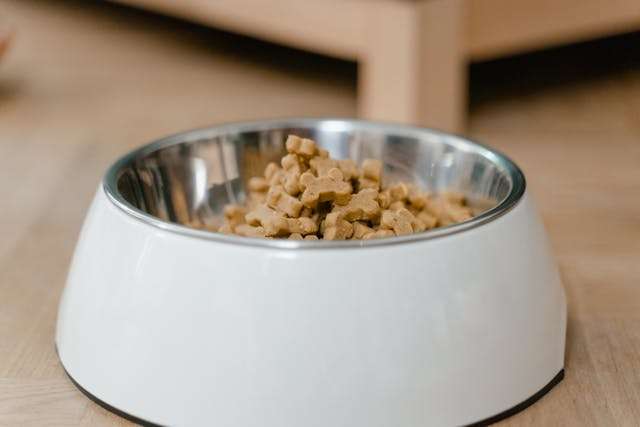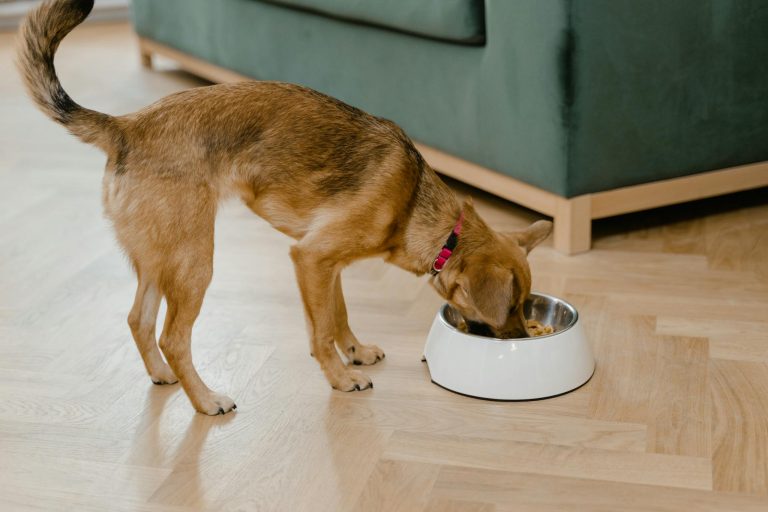15 Dog Food Ingredients To Avoid That Are Toxic For Dogs

I’m Health-conscious and used to reading food labels closely, but it’s a good idea for every pet parent to do the same regarding dog food.
My extensive research has revealed 15 dog food ingredients to avoid. When listed, these ingredients should immediately raise red flags as they can potentially harm your dog’s health.
Table of Contents
1 BHA/BHT
The FDA has approved these for human foods, and there’s a long history of using them to keep processed food fresh. Yet, emerging research shows they can contribute to health problems like allergies and could have carcinogens.
While it is true that a lot of manufacturers do follow strict guidelines and use high-quality ingredients, some still include less than beneficial ingredients. Sometimes, you will even find harmful ingredients that should be avoided altogether. Two such ingredients that should be avoided are Butylated Hydroxytoluene and Butylated Hydroxyanisole, or BHT and BHA. [1]
What are BHA and BHT?
BHA and BHT are synthetic antioxidants. They were first used in the 1940s, with BHA hitting the pet food scene first, followed by BHT. In some respects, they can be compared to vitamin E. Vitamin E is an antioxidant used to keep food fresh, which is precisely the job of these two seemingly innocuous ingredients.
Not only are BHA and BHT found in dog and cat food, but they are also found in processed food for humans. Does this mean that they are safe? Let’s find out.
Antioxidants
BHA and BHT are antioxidants, and they were first devised as a safe, synthetic alternative to natural preservatives.
Antioxidants help the body fight free radicals and they can also detoxify chemicals within the blood. They are generally considered essential, and they are just as important to dogs as they are to people.
You will see a lot of commercial dog foods boasting that they contain natural antioxidants like blueberries. These ingredients are not necessarily associated with dogs but are added for nutritional benefit.
Because BHA and BHT are antioxidants, it is easy to see them as beneficial food additives. However, despite their benefits, they have been linked to cancer in canines, and thus, they aren’t a safe choice for dogs.
Cumulative Feeding
One of the most significant issues with feeding these products to our dogs is that we do so regularly. The dog has no choice but to eat what we feed it, and we give food containing BHA and BHT two or three times a day, every day.
The more exposure a dog has to these ingredients, the more likely it is that they will suffer some type of ill effects as a result, but we continue to feed them.
BHA and BHT Healthy Alternatives
What makes the situation worse is how readily available natural preservatives are. Vitamin C and vitamin E are commonly used natural alternatives. Rosemary oil is another ingredient that enjoys the same positive effects without proving dangerous for your best friend.
2 Fish Meal
The side effects of fish meal are so dangerous that it’s banned in the European Union. However, it’s used in dog food ingredients in the United States. It’s been shown to cause hemorrhages, cancer, and damage to the liver, kidneys, and thyroid. So, steer clear of this incredibly fishy ingredient.
What is Ethoxyquin? Ethoxyquin is an artificial preservative found in most manufactured American commercial dog food. While Australia and Europe do not allow Ethoxyquin in dog food, it is an approved additive by the U.S. Food and Drug Administration (FDA) for use in animal feed.
In a study, chemical preservatives in dog food, including Ethoxyquin and others, have been linked to kidney failure in dogs. The exact mechanism by which these preservatives may lead to kidney failure has yet to be well understood.
Still, it is believed that they may cause damage to the kidneys over time. Sadly, the toxicity is extreme in the recipes.
Fish Meal Healthy Alternative
- Vitamin C (ascorbic acid)
- Vitamin E (mixed tocopherols)
- Rosemary
Warning: Rosemary is not recommended for dogs with seizure disorders. If your dog has a health condition, check with your vet to confirm whether rosemary might affect it.
The U.S. Environmental Protection Agency (EPA) recognizes it as an insecticide, fungicide, and rodenticide. It is a skin irritant and can be harmful if inhaled, according to a fact sheet by the Food & Water Watch.
The National Institute for Occupational Safety and Health (a division of the CDC) suspects it may be a neurotoxin. Would you believe it is still generally regarded as safe to eat?
Sodium tripolyphosphate is often added to pet food as a preservative. It might be hard to believe, but it’s true! [2]
3 White Flour
If your dog does have a wheat allergy, or you suspect she might, look for an alternative. But even if your dog is not allergic to wheat, white flour isn’t the best option.
White flour is a simple carbohydrate substance with most (if not all) of its nutrition stripped – an unwanted filler. The problem with white flour is that after ingestion, it causes a spike and then a drop in blood sugar, causing your pup to be hungry again soon after consuming it.
Overconsumption of white flour can lead to weight gain, obesity, and diabetes in dogs, mainly when used as an additive in dog foods for convenience.
Check the food label to determine if it is an additive before purchasing for your pup. You want to ensure the best nutrition for your pet.
Healthy Alternative:
White flour is not necessary for your diet or your pet’s – choose nutritious, novel whole grains instead as the ingredients in the dog foods. Whole grains like quinoa, oats, or brown rice are great alternatives for pets and humans. [3]
4 Artificial Colors
Dog food coloring can be either natural or artificial.
Dyes, considered “natural,” are derived from an organic source, which can be anything from veggies to spices to algae to beetles. However, although the base ingredient is organic, these dyes may still be heavily processed or treated with synthetic additives.
Artificial food coloring is derived from petroleum. Yes, petroleum! While dozens of artificial food coloring agents have been banned over the years, some synthetic dyes are still legal and widely used in dog food and treats.
The U.S. Food and Drug Administration (FDA) reviews the risks of artificial food coloring ingredients. Over the years, it has banned dozens of synthetic dyes due to their toxicity or side effects.
The artificial food coloring agents that pet companies use today are approved by the FDA and follow the FDA’s guidelines outlining their use. As Dogs Naturally Magazine reports:
“The FDA currently certifies nine synthetic dyes. The most commonly used ones are FD&C Blue 1, Blue 2, Green 3, Red 3, Red 40, Yellow 5, and Yellow 6. They are all derived from petroleum. Manufacturers like their bright tones and stability in products. They are also cheaper than natural alternatives.
Red, yellow, and black iron oxides are also FDA-approved for some uses and are found in pet food. Iron oxide’s better-known name is, of course, rust. While the FDA considers these approved dyes safe, it’s controversial, and some are banned in other countries.” [4]
5 MSG
The Dangers Of MSG For Dogs
MSG is likely quite bad for dogs. And it’s scary to think that MSG might damage your dog’s brain.
Dr Russell Blaylock, author of “Excitotoxins: The Taste that Kills,” says that it can cause brain damage (in humans) and may trigger or aggravate learning disabilities as well as diseases like Alzheimer’s, Parkinson’s, and Lou Gehrig’s.
Seizures In Dogs
Veterinarian nutritionist Dr Veneta Kozhuharova DVM, MRCVS, Cert.CFVHNUT (certified in Canine and Feline Veterinary Health Nutrition) has found that glutamate or MSG in dog foods can lead to seizures in dogs.
She cites a study at London’s Department of Neurology, Institute of Psychiatry, finding that “Glutamate is the principal excitatory neurotransmitter in the brain and, as such, it inevitably plays a role in the initiation and spread of seizure activity.”
But that’s not all. Studies have shown other potential risks.
A study in the 2008 Journal of Autoimmunity showed that injecting MSG into mice led to liver inflammation, along with obesity and Type 2 diabetes.
Studies by Dr John Olney at Washington University using neonatal mice and varying injected doses of MSG found that the injections caused obesity, neuroendocrine disturbances, behavioral disturbances, as well as fetal brain damage in mice whose mothers ate it when pregnant.
Other animal studies have shown that MSG is toxic to organs such as the liver, brain, thymus, and kidneys.
Worse, the effects accumulate over time. So, if your dog eats food with MSG daily, it may take a while for the effects to appear.
Symptoms of MSG Poisoning In Dogs
- Vomiting or diarrhea
- Thirst/drinking a lot
- Lethargy
- Lack of coordination
- Seizures or tremors
How To Avoid MSG
It can also appear under other names, including:
- Any protein isolate (like soy protein isolate)
- Any textured protein (such as textured vegetable protein)
- Autolyzed yeast
- Hydrolyzed yeast
- Yeast extracts or yeast nutrients or yeast food
- Soy extracts
- Soy concentrate
- Sodium caseinate or calcium caseinate
- Disodium inosinate or disodium guanylate (which are flavor enhancers effective only in the presence of MSG)
- Monopotassium glutamate
- Glutamate, glutamic acid, or free glutamate [5]
MSG Healthy Alternative
Including chicken, beef, or pork in your pet’s dog food would eliminate the need for flavor enhancers. The meats are not only ideal for pets but also humans. Study each ingredient to see if it is real.
6 Gluten
Few dog food ingredients get as much buzz in the press or with pet parents as gluten, even in cereals. While many people avoid gluten to improve their digestion and even lose weight, your dog’s reasons for avoiding gluten might be even more compelling. [6]
Gluten is generally harmless for dogs, but some may be sensitive. Gluten intolerance or celiac disease in dogs can cause long-term damage, and symptoms include:
- Chronic gastrointestinal upset
- Bloating
- Stomachache
- Poor fur coat and hair loss
- Frequent scratching, chewing, and licking
- Redness or inflammation of the skin
- Ear inflammation
- Flatulence
- Loose stool and diarrhea
- Weight loss
Gluten Healthy Alternative
Gluten is often used in dog food to help kibble, treats, and wet food keep their shape and add flavor. However, there’s no scientific evidence that gluten-free diets are better for healthy pets than other balanced diets. If your dog is sensitive to wheat or other grains, try feeding them oats instead, as they are high in protein and low in gluten.
7 Corn Syrup
Corn syrup isn’t toxic to dogs, but its high sugar content makes it less than ideal for dogs to eat. As a general rule, it’s best to avoid giving dogs corn syrup.
If your dog has diabetes, however, your vet may advise giving them corn syrup if they experience low blood sugar (hypoglycemia).
However, Corn syrup is problematic on many levels and is a very controversial dog food ingredient. It is an added sugar used to sweeten many dog foods, even though it isn’t needed.
While taste is important, with the known downsides of regularly ingesting corn syrup and heavy sugar consumption, it’s hard to justify including it in your dog’s diet. Corn syrup can result in weight gain, diabetes, tooth decay, hyperactivity, and mental behavioral problems.
Corn Syrup Healthy Alternatives
In general, dogs should not eat added sugar. Naturally occurring sugars in foods can be broken down with regular digestion, so if you’re concerned about your dog enjoying the taste of dog food, look elsewhere to enhance the flavor. [7]
8 Salmon Precautions
Is it safe to feed your salmon to your dog? According to the American Kennel Club, the answer is yes. Unless, of course, your dog is allergic to it and you follow the preparation guide below.
Salmon is not just safe, but it’s also a nutritional powerhouse for your dog. It’s packed with omega-3 fatty acids. They support the immune system, reduce inflammation, and keep your dog’s coat shiny and healthy. This nutritional profile makes it an excellent choice for your dog’s diet.
Salmon is also a good protein source and a common ingredient in high-quality dog foods. If your dog is allergic to more common protein sources, such as chicken, salmon may be a good alternative.
Prepare Fresh Salmon for Your Dog’s Meal
To kill parasites and bacteria, you must cook salmon. Raw or undercooked salmon poses significant health risks to dogs. Cook salmon in an oven or on a grill. Remove bones, skin, and fat to make it safe. Feed your dog small amounts to prevent digestive upset.
Never give your dog raw or undercooked salmon. It can contain the Neorickettsia helminthoeca parasite, which causes salmon poisoning disease. This disease can be fatal. Furthermore, raw salmon has many small bones. They are brittle and can choke your dog or get stuck in their stomach or intestines.
However, well-cooked, boneless salmon is on that list. It’s for people who approve of dog food. Choose fresh, boneless fillets since they’re less likely to harbor small bones. But be sure to check for tiny bones anyway before cooking. Then, poach, grill, roast, steam, or bake the salmon. Do so with no oil, salt, pepper, or other seasonings, like garlic or onions.
Remember, like with any food, portion control is key. Serve your dog an appropriate portion size, and limit salmon intake to once a week or less. Canned salmon can also be a good alternative; make sure it’s packed with water.
So, the next time you grill or bake a fresh piece of salmon, set a small piece aside to cook for your dog. It’s good for them, and they’ll love it.
9 Xylitol
According to the U.S. Food and Drug Administration “This sugar substitute, found in some human foods and dental products, can be poisonous to your dog”.
Scenerio: Your six-month-old puppy, who will eat anything that isn’t tied down. Like many dog owners, you know chocolate can be dangerous to your pup. But you may not know that the consequences could be deadly if your puppy sticks his nose in your handbag and eats a pack of sugarless chewing gum.
Sugarless gum may contain xylitol, a class of sweetener known as sugar alcohol. Xylitol is present in many products and foods for human use but can have devastating effects on your pet.
If you think your dog may have eaten a product containing xylitol, immediately call your vet, emergency clinic, or animal poison control center.
Over the past years, the FDA’s Center for Veterinary Medicine has received many reports. Most were about chewing gum. They were about dogs being poisoned by xylitol, according to Martine Hartogensis, a veterinarian at the FDA. The most recent report was related to “skinny” (sugar-free) ice cream.
You may have heard news stories about dogs that have died or become very ill after eating products with xylitol. Xylitol may also be known as birch sugar or wood sugar.
Other Foods Containing Xylitol
Gum isn’t the only product that contains xylitol. This sugar substitute is slightly lower in calories than sugar. It is also used to sweeten sugar-free candy. This includes mints, chocolate bars, and chewing gum. Other products that may contain xylitol include:
- breath mints
- baked goods
- cough syrup
- Children’s and adult chewable vitamins.
- mouthwash
- toothpaste
- Some peanut and nut butter.
- over-the-counter medicines
- dietary supplements
- Sugar-free desserts, including “skinny” ice cream.
Xylitol can also be used in baked goods, such as cakes, muffins, and pies. This is often because the baker is substituting another sweetener for sugar. This is common in products for people with diabetes.
People can buy xylitol in bulk to bake sweet treats at home. In-store bakeries also sell baked goods containing the sweetener. Some pediatric dentists also recommend xylitol gum for children.
These products could end up in a dog’s mouth by accident. Keeping all such products out of your dog’s reach is a good idea.
Why is Xylitol dangerous to dogs but not to people?
In both people and dogs, insulin from the pancreas controls blood sugar. In people, xylitol does not stimulate insulin release from the pancreas. However, it’s different for dogs. Xylitol is rapidly taken up by the bloodstream after ingestion. This may lead to a substantial insulin release from the pancreas.
This rapid insulin release may cause a swift and profound drop in blood sugar. This effect can occur within 10 to 60 minutes of eating xylitol. Hartogensis warns that untreated hypoglycemia poses a mortal danger.
A note to cat and ferret owners: Xylitol is less dangerous for cats and other pets. Cats appear to be spared, at least partly, by their disdain for sweets. Ferret owners should be careful. Like dogs, ferrets can get low blood sugar and seizures after eating xylitol.
Symptoms to Look for in Your Dog
Help protect dogs by displaying this flyer (PDF 1.3 MB) in animal shelters, pet stores, and veterinary clinics in your neighborhood.
Dogs poisoned by xylitol vomit. Then, they have symptoms from a sudden drop in blood sugar. These symptoms include decreased activity, weakness, staggering, incoordination, collapse, and seizures.
If you think your dog has eaten xylitol, take him to your vet or an emergency animal hospital immediately, Hartogensis advises. Hypoglycemia and other serious effects may not occur for 12 to 24 hours. So, your dog may need to be hospitalized for medical monitoring.
What Can You Do to Avoid Xylitol Poisoning in Your Dog?
Dr. Hartogensis says, “Check the label for xylitol in product ingredients. Do this for those that advertise as sugar-free or low-sugar. If a product contains xylitol, ensure your pet cannot get it.” In addition:
- Keep products with xylitol away from your dog. This includes non-food items like toothpaste. Remember that some dogs are adept at counter-surfing.
- Only use pet toothpaste for pets, never human toothpaste.
- Check the label first if you give your dog nut butter as a treat or for pills. Make sure it doesn’t contain xylitol.
10 Rendered Fat
This ingredient comes from animal fat. Like meat by-products, it isn’t easy to trace their source. Many companies get rendered fat from leftover meat by-products from livestock animals, but it could also include roadkill.
If that wasn’t bad enough, rendered fat can be contaminated with plastics, antibiotics, and even sodium pentobarbital, which is the drug used to euthanize animals.
Because of this, rendered fat can become a breeding ground for mold and harmful microorganisms like salmonella. It also contains high levels of toxins, such as heavy metals, which are highly concentrated in their fat content. [8]
Rendered Fat Healthy Alternative
Named ingredients such as salmon oil, chicken fat, beef fat, lamb fat, pork fat, and coconut oil are better options that provide nutrition and energy.
11 Brewers Rice
Brewer’s rice is a common carbohydrate source in low-quality dog foods, but it’s also an ingredient you should avoid. While it may sound like whole grain, brewer’s rice is not.
The key to your dog’s health regarding brewer’s rice is how it fits in on the ingredient list and whether it comes from a reliable source. Most super-premium foods use rice, which is richer in nutrients.
It’s common to see rice listed first to fourth on the ingredients list. Grains containing carbohydrates and too many carbs can rapidly increase your pet’s weight. Pet food using ‘meal’ instead of meat may have grains higher on the ingredient list.
Some pet food companies also do something called ‘ingredient splitting.’ The ingredient list says ‘wheat,” wheat flour,’ and ‘wheat gluten.’
That is because ‘meal’ contains more nutrients and weighs less. ‘Meal’ is real meat with the water and fat removed.
Real meat in pet food weighs more because of the moisture (water) in the meat. Diets using real meat can be deceiving because the beef list will be higher than the grains due to the water weight. These diets may have more carbohydrates than pet owners are aware of.
Brewers Rice Healthy Alternative
Look for the best whole-grain sources or whole vegetable and legume carbohydrate sources in dry dog food for more nutrition, healthy growth, and longer-lasting energy for your dog. Veggies are an excellent option for whole grains. [9]
12 Sodium Hexametaphosphate
Can you pronounce Sodium Hexametaphosphate? If an ingredient is hard to pronounce, that’s a clue that you should be wary of.
Sodium hexametaphosphate is commonly used in dog chewables marketed as dental products. While it effectively whitens teeth after extended use, it is strongly associated with cancer and kidney problems.
Don’t trust an ingredient just because it’s used in a dental product; that doesn’t guarantee it’s good for your dog. Always read labels for ingredients to avoid in dog food before giving your pet a chewable.
It’s better to brush your dog’s teeth and choose foods that don’t contain this worrisome ingredient. Nothing should replace regular dental care for your pet anyway, so don’t buy dog food that can cause indigestion or long-term impacts on a dog’s health.
Sodium Hexametaphosphate Healthy Alternatives
It’s better to brush your dog’s teeth and choose foods that don’t contain this worrisome ingredient. Nothing should replace regular dental care for your pet anyway, so don’t buy dog food that can cause indigestion or long-term impacts on a dog’s health. [10]
13 Soy Beans & Soy Bean Products
Few ingredients are as controversial as soy for both humans and pets. Most consider it an unwanted filler ingredient. But, while soy may have some benefits for you and is considered safe by the FDA experts, there are a few things it does for pets.
Why is it included in pet food? Like corn, it is often used to increase the protein content in dog foods of poor quality. Admittedly, soy is one of the few plant protein sources that contain all essential amino acids. However, as mentioned earlier, grain and vegetable-based protein sources are less bioavailable to pets than meat protein.
While soy is one of those few plant protein sources that contain all necessary amino acids, there are still reasons it is not good. Soy is often problematic for pets to digest, causing bloat and gas.
A cheap ingredient in dog food and dog treats, it is plentiful in many low-quality pet foods as a protein percentage booster.
A common allergen, soy is best to avoid in dog food altogether if you have pets. Look on the food label to determine if the brand contains soy.
If it is high in soy, do not feed it to your pup. Soy is one of the ingredients to avoid when picking a dog food brand that provides the best nutrition for your pet. [11]
Soy Beans Healthy Alternative
The best proteins for your pet are meat-based proteins. Eggs and named meats or meat meals have high bioavailability for dogs and cats. These protein sources have complete amino acid profiles for both dogs and cats and are easy for pets to digest, making them a great addition to the best dog food for the most outstanding nutrition and needs. They are suitable for everyone.
14 Sodium Tripolyphosphate
Did you know sodium tripolyphosphate is used to soften water and is the active ingredient in many detergents?
The U.S. Environmental Protection Agency (EPA) recognizes it as an insecticide, fungicide, and rodenticide. It is a skin irritant and can be harmful if inhaled, according to a fact sheet by the Food & Water Watch. The National Institute for Occupational Safety and Health (a division of the CDC) suspects it may be a neurotoxin. Would you believe it is still generally regarded as safe to eat?
Sodium tripolyphosphate is often added to pet food as a preservative. It might be hard to believe, but it’s true! [12]
Sodium Tripolyphosphate Healthy Alternative
Opt for dog food that uses natural preservatives instead, like rosemary extract. Warning: Rosemary is not recommended for dogs with any seizure disorder.
If your dog has a health condition, check with your vet to confirm whether rosemary might affect it.
15 Propylene Glycol
Propylene glycol is a synthetic liquid substance added to some dog foods and treats to help maintain texture, keep them soft, lock in moisture in semi-moist foods, and prevent bacterial growth. Here’s the shocker: it can also be used in antifreeze.
Even though it is considered a non-toxic alternative, the truth is that the FDA has banned propylene glycol from cat treats. Still, the FDA says this substance is Generally Recognized As Safe (GRAD) for canines.
The problem is that it is still considered toxic to dogs at certain levels. Constant exposure to this preservative, which is banned in some countries, is a cause for concern.
This is artificial additive moisture in semi-moist foods.
Although your dog’s liver can safely metabolize it into safe compounds, manufacturers assure us that it is safe for use in food, and propylene glycol may be toxic in large amounts. [13]
Tips To Keep Your Dog Healthy
I know you only want to give your beloved pup the excellent stuff. Many high-quality, super-premium, minimally processed dog foods contain nutritional ingredients such as free-range chicken, organic vegetables, and whole fruits with antioxidants.
However, you might reconsider whether a higher price equals higher quality. Always read the ingredient list carefully. Unfortunately, “chicken” on a label can mean scraps from a caged chicken, or the manufacturer is using free-range chicken. It’s hard to tell.
What to do? The simple advice is to avoid the top ten artificial additives or cheap, questionable ingredients many manufacturers use to lower costs and increase profits.
Remember, you are the guardian of your furry friend’s nutrition. Your role is crucial, so when in doubt, err on caution. You have the power to choose the best for your pet. Put the dubious dog food down and back away.






